The passionvine hopper (Scolypopa Australis) is a significant moth-like pest in New Zealand, mostly in vineyards and orchards — particularly affecting grapevines, kiwifruit, and passionfruit. They are sap suckers and will attack unhealthy plants. Learn more at Plant Doctor.
An insect is a type of arthropod, which is a group of invertebrate animals that have a segmented body, jointed legs, and an exoskeleton. Insects have three distinct body parts: the head, thorax, and abdomen, as well as three pairs of legs and usually one or two pairs of wings.
There are over a million known species of insects, and it's estimated that there may be many more that have not yet been discovered.
Activity – Insects are our friends

This is a depiction of the insect world, available at Te ara. If you have ever been bitten by a sandfly, you may like to visit the link to see the Māori legend explaining why they bite us.
Te aitanga pepeke (the insect world) features in several Māori creation stories.
It is said that Whiro (God of the Underworld) formed an army of insects and later an army of birds and insects which he sent to attack his brother, Tāne (God of the Forest). Tāne defeated these war parties and brought them to earth as prisoners, where “they dwelt among the trees under the care of Tāne, whose domain was the forests” (Haami, n.d.).
Te Ara, The Encyclopedia of New Zealand, contains a collection of Māori stories that involve insects and bring attention to the sacredness of the forest: Story: Te aitanga pepeke – the insect world
Let’s take a look at the main parts of an insect’s body and some of their most identifiable features. Like with plants, if we know what the different parts look like, and the words used to describe them we’ll stand a much better chance of being able to identify them.
Insects have three main body parts: the head, thorax, and abdomen.
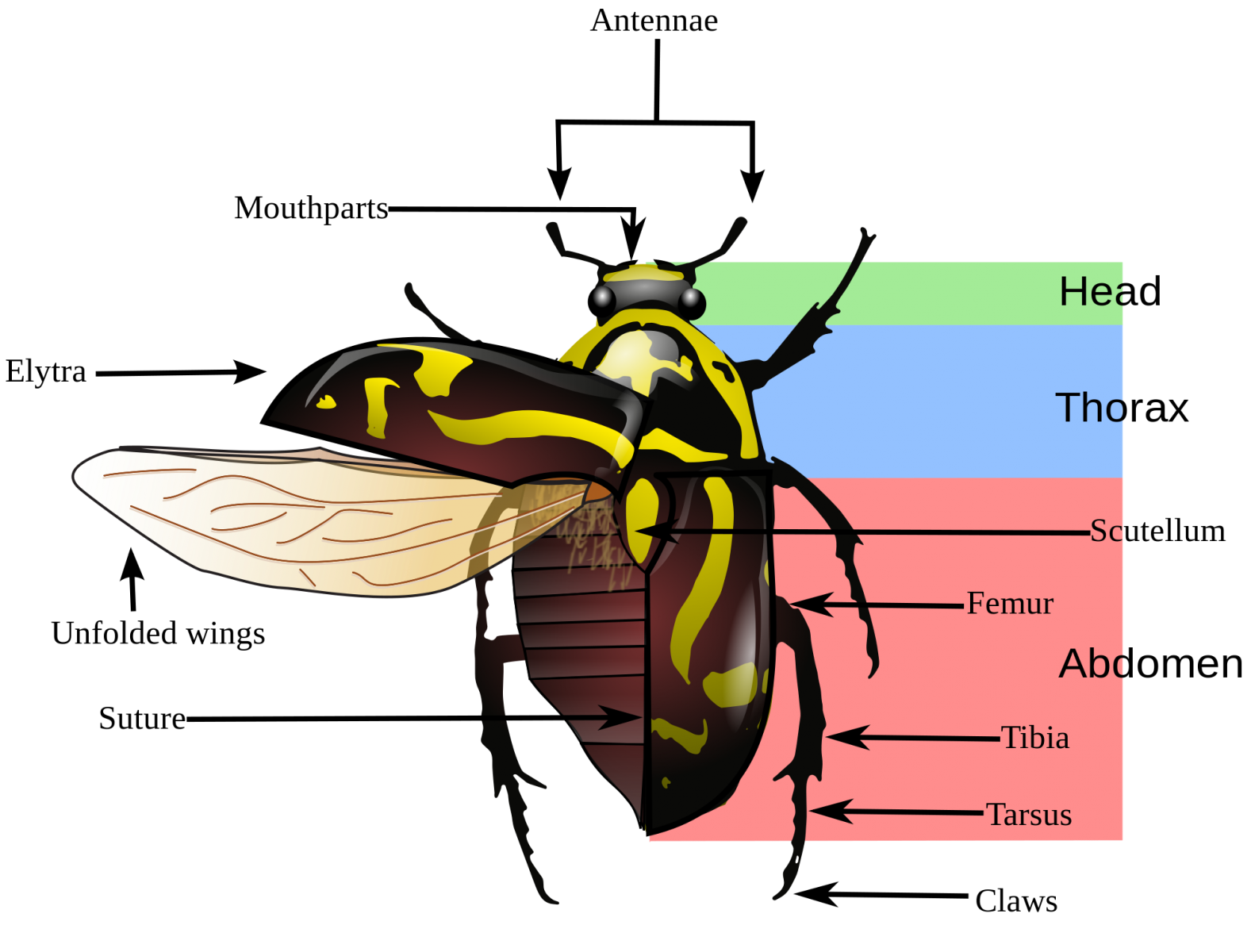
Head
- The eyes are often large and compound, made up of many tiny lenses that allow the insect to see in all directions.
- The antennae are used for touch, taste, and smell, and vary in shape and size between different types of insects.
- The mouthparts can also vary depending on the insect's diet:
- some have mandibles for chewing
- others have a proboscis for sucking nectar.
Thorax
The thorax is the middle part of the insect's body and contains the wings and legs.
Insects have three pairs of legs, each with several segments, and the segments can be modified depending on the insect's mode of movement. For example, grasshoppers have powerful hind legs for jumping, while bees have flattened hind legs for collecting and transporting pollen.
The wings are also attached to the thorax, and can be modified for different types of flight, such as gliding, hovering, or rapid movement.
Spiders have only two main body parts:
| cephalothorax | A combination of head and thorax |
| abdomen | The belly. It contains the guts, heart, reproductive organs, and silk glands. |
Abdomen
The abdomen is the rear part of the insect's body and contains the digestive and reproductive organs and silk glands.
In some insects, such as wasps and bees, the female has a stinger at the end of the abdomen for self-defense. The shape and size of the abdomen can also vary depending on the insect's diet and lifestyle, such as the swollen abdomen of a termite queen, or the long, slender abdomen of a dragonfly as shown in the following images.
 After the termite takes over her role as queen, her abdomen gets extremely large to accommodate all of the eggs she will be producing. |
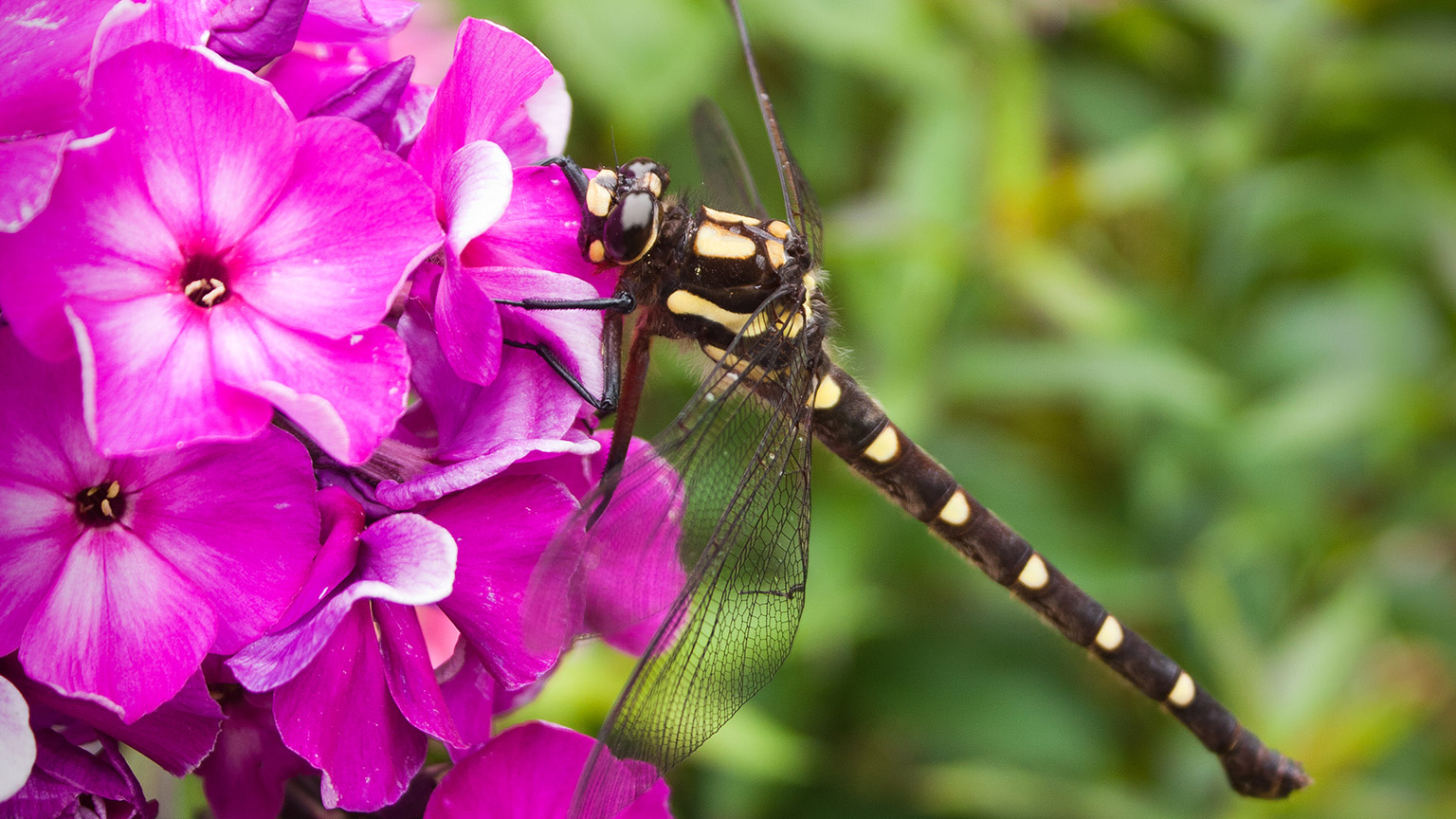 Uropetala carovei is a giant dragonfly of the family Petaluridae, endemic to New Zealand. Its Māori name, kapokapowai means "water snatcher". |
Other identifying features
Some of the main features used to identify nymph and adult insects are:
- Mouthparts: The type of mouthparts an insect has can be used to identify its group. For example, chewing mouthparts are found in grasshoppers and beetles, while syphoning (also called piercing-sucking) mouthparts are found in butterflies and moths.
- Wings: The size and shape of wings can also help identify different types of insects. Some insects, like bees and wasps, have clear wings, while others, like beetles and ladybugs, have hardened forewings (elytra).
- Where an insect has two pairs of wings, the term wing is used to describe the front set of wings. The term hindwing is used to describe the rear set of wings.
- Legs: The number and structure of legs can also be used to identify insects. For example, grasshoppers and crickets have long hind legs adapted for jumping, while spiders have eight legs and are not considered insects.
- Antennae: The shape and length of antennae can be used to identify different types of insects. For example, butterflies and moths have clubbed antennae, while grasshoppers and crickets have long, thread-like antennae.
- Body shape and coloration: The overall body shape and coloration of an insect can also be used for identification. For example, beetles have a hard, shell-like body and can come in a variety of colours and patterns, while true bugs have a characteristic triangular shape.
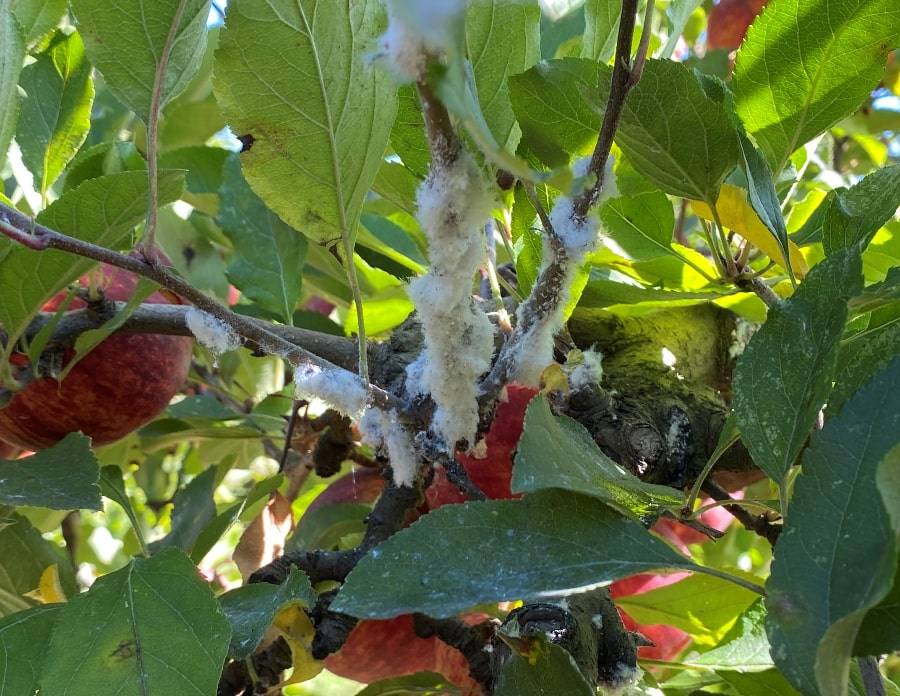
The woolly aphid (Eriosoma lanigerum), introduced in this programme previously, is an example of a true bug pest in New Zealand. They have spread into every apple-growing region in the world.
A true bug is a type of insect belonging to the order Hemiptera, which includes over 80,000 known species. True bugs are characterised by their mouthparts, which are modified into a beak-like structure called a rostrum that is used for piercing and sucking fluids, and they have two sets of wings with the front set having a thickened base and membranous tips.
Identifying insects in their larval or pupal stages can be more challenging than identifying adult insects, as they may have different physical features and behaviours.
Identifying features include the following:
- Body shape and coloration: As for nymphs and adults.
- Head capsule: The size and shape of the head capsule can also be used to identify insect larvae. For example, the head capsules of beetle larvae are usually hard and distinct, while the head capsules of caterpillars are soft and usually blend in with the body.
- Mouthparts: As for nymphs and adults.
- Habitat and behaviour: The habitat and behaviour of the insect can also provide clues about its identity. For example, some insect larvae are aquatic, while others are found on plants or in soil.
Read Insect Mouthparts on the Amateur Entomologists’ Society webpage, which contains images and descriptions of common mouthparts.
Activity – Order the ant parts
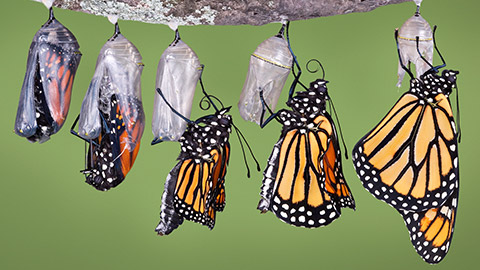
The monarch butterfly, (Danaus plexippus), a four-stage lifecycle insect, is beloved in gardens throughout Aotearoa, New Zealand. This butterfly is emerging from the pupa stage into adult life.
The lifecycle stages of insects generally fall into one of two groups:
- Incomplete metamorphosis (three-stage lifecycle): insects such as grasshoppers, dragonflies, and bugs, where their young stage look a lot like their adult form but are smaller, and some parts are smaller in relation to the body. Generally they will live in similar spaces and eat similar foods to their fully-grown counterparts.
- 1. Egg: Insects start out as eggs.
- 2. Nymph: When the eggs hatch, the insects are nymphs. During this stage their features, such as wings, may start out as small bumps called wing buds and get larger each time they moult.
- 3. Adult: When fully-formed they are adults. This is usually the reproductive stage of the insect's life, during which it mates and lays eggs to start the lifecycle anew.
- Complete metamorphosis (four-stage lifecycle): insects such as beetles, butterflies, moths, flies, bees, and wasps, where the young stages are very different to the final adult form. They occupy a completely different habitat and eat different foods.
- 1. Egg: Insects start out as eggs.
- 2. Larva (also known as grub or caterpillar): When the eggs hatch, the insects are larvae (larvae is the plural of lava).
- 3. Pupa: “Instead of undergoing a series of small changes to reach the adult form, the larvae undergo one very dramatic change that requires a special resting and non-feeding stage during which the transformation can occur. This resting stage is called the pupa. In this group, the wing buds develop internally and are not visible until the pupae stage” (Wallace, 2013). Pupae is the plural of pupa.
- 4. Adult: The insect emerges from the pupal case as a fully-formed adult and is able to reproduce.
Instars and moults
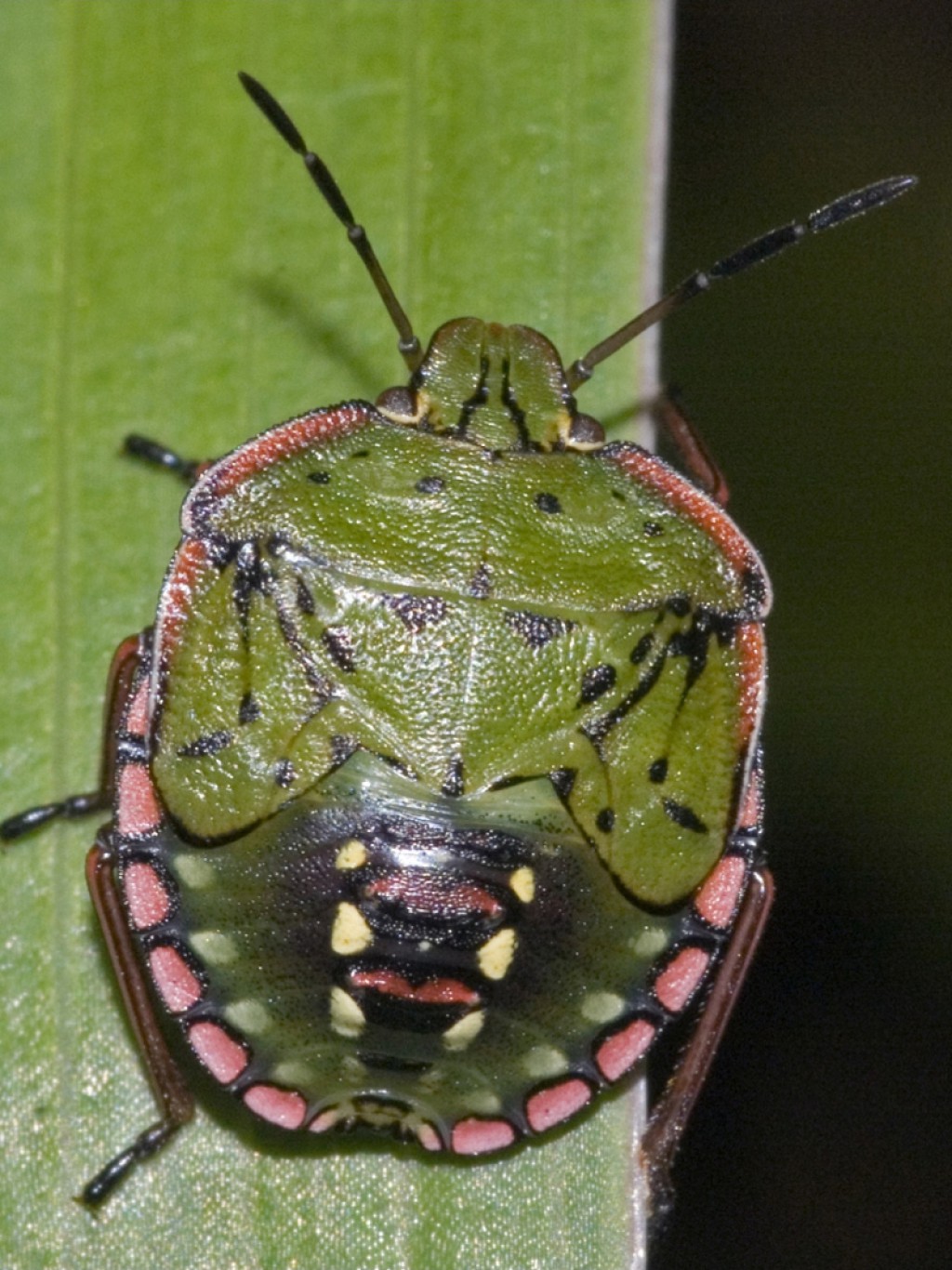
This young insect, instar nymph of the southern green stink bug (Nezara viridula) is in the Pentatomidae family and is a type of true bug. Some people squash them directly on the leaves of their plants because the smell may be a deterrent for other stink bugs.
Instar refers to one of the developmental stages of arthropods, between moults.
During each instar, the arthropod undergoes a period of growth and development, during which it sheds its old exoskeleton and replaces it with a new, larger one. Each instar is defined by the arthropod's body size, shape, and coloration, which can change significantly over time as the animal grows and matures.
An exoskeleton is a hard and protective outer covering that supports and encases the body of certain invertebrate animals, such as arthropods. Unlike vertebrate animals (fish, mammals, birds) that have an internal skeleton made of bone, arthropods rely on their exoskeleton to provide support, protect their soft tissues, and serve as a point of attachment for muscles.
Moulting is the process by which arthropods shed their old exoskeleton and replace it with a new, larger one.
During each instar, a caterpillar sheds its skin and grows larger, while also developing new physical features such as bristles, colouration, and other distinguishing characteristics. The number of instars a caterpillar goes through can vary depending on the species but typically ranges from three to six.
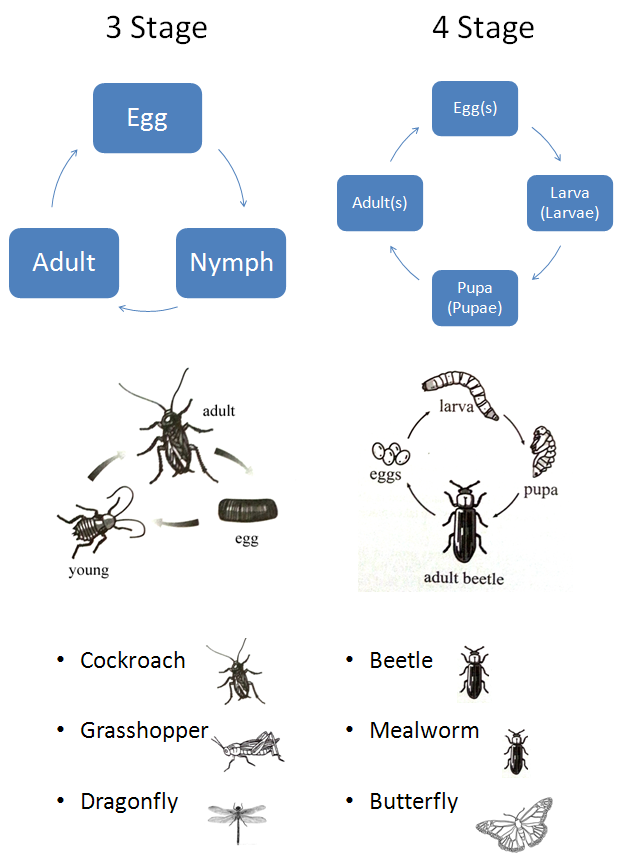
More information about lifecycle stages can be found on the Amateur Entomologists’ Society webpage: Insect Life Cycles.
These terms and identifying features will come in handy when we talk about common insect pests, next, and when you start using research tools to identify pests you see around you.
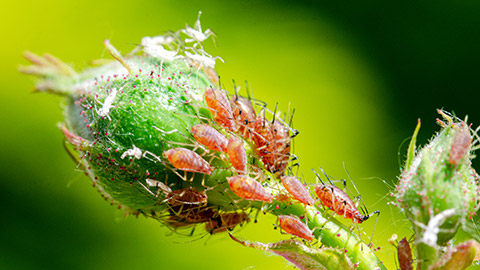
Now that we’ve learned about insects, we’ll turn our attention to those ones that give gardeners a hard time in Aotearoa: the insect pests. We’ll revisit some of the pests described earlier to build on what we already know, and we’ll introduce some new ones.
If you need to refresh your memory, review Module 2.5 Pests, Disease, and Weed Control.
In this subtopic we’ll learn about:
- their key identifying features
- the damage they cause
- during which lifecycle stage or stages this damage occurs
- what time of year this generally occurs.
We’ll come back to these in the topic on integrated pest management to consider how best to prevent and control them.
Aphid (family: Aphididae)
![[ADD IMAGE'S ALT TEXT]](/sites/default/files/Soybeanaphid.jpg)
Source: Wikipedia contributorsThe Aphididae are a very large insect family in the aphid superfamily Aphidoidea...many of which are considered plant/crop pests. There are several thousand species of aphids, and they are the family of insects that are known to carry the most different types of plant virus – some 200.
Lifecycle stages
It is difficult to describe the lifecycle of aphids because they vary in response to environmental factors. Aphids can switch between giving birth to live young without mating, or reproducing sexually by laying eggs depending on the amount of daylight they experience. This is useful in that the eggs can overwinter, though some species of aphids overwinter as nymphs or adults. Overwintering refers to the process by which plants and animals survive the winter season.
Identifying features
Aphids are small. Only a few millimetres long. There are several features or characteristics that can be used to identify an insect as an aphid:
- Body shape: Aphids have a distinctive pear-shaped body with a narrow "waist" called a ‘constriction’ between the thorax and abdomen.
- Antennae: Aphids have two long, thin antennae that are about the same length as the body.
- Mouthparts: Aphids have a long, slender proboscis (or rostrum) that they use to pierce plant tissues and feed on sap.
- Legs: Most aphids have six thin, spindly legs that are positioned towards the front of the body.
- Cornicles: Aphids have two small, finger-like projections called cornicles that extend from the end of the abdomen. These structures are used to produce pheromones for communication.
- Wings: Some species of aphids have wings, while others are wingless. Winged aphids may have transparent or coloured wings, and they may be used for dispersal.
Aphids can vary in colour depending on the species and life stage. They may be green, brown, yellow, black, or reddish in colour, so colour isn’t a useful identifying feature.
Aphids can reproduce rapidly, which means that infestations can quickly grow and spread throughout a crop.
Damage
Aphids are most problematic in the warmer months from spring to autumn.
Some crops are particularly vulnerable to aphid damage, such as vegetables, fruits, and ornamental plants. For example, aphid infestations can cause curling, wilting, and discoloration of leaves, which can result in reduced photosynthesis and lower yields. In addition, the honeydew produced by aphids can attract other pests, such as ants and wasps, which can further damage crops.
Aphids and grapes
The Phylloxera (Dactylosphaera vitifoliae) story
The damage from this small aphid strikes fear in wine growers worldwide though most of the damage at this point is historical. The pest made headlines in Otago as recently as 2002.

Altitude ToursThere is a saying in wine making that there are only three certainties in life: death, taxes and Phylloxera (Dactylosphaera vitifoliae).
Cabbage white (Pieris rapae)
Use the navigation below this image slider to view the life stages of the Cabbage white butterfly.
Lifecycle stages
The cabbage white has a four-stage lifecycle:
- Egg: The lifecycle begins when the female butterfly lays her eggs on the underside of a leaf.
- Larva: After about 3-5 days, the eggs hatch into caterpillars, also known as larvae. The caterpillars are green and have small black spots.
- Pupa: After feeding for about 15 days, the larva forms a chrysalis or pupa. The chrysalis is green at first but later turns brown. It is usually attached to a stem or leaf by a silk thread.
- Adult: After about 10-14 days, the adult butterfly emerges from the chrysalis. The cabbage white butterfly has white wings with black tips and black spots. The male and female butterflies look similar, but the female is usually larger.
After mating, the female butterfly lays her eggs on the underside of a leaf, and the lifecycle begins again. Female cabbage butterflies lay between 300-400 eggs in their lifetimes.
Overall, the lifecycle of the cabbage white takes about 4-6 weeks from egg to adult, depending on temperature and other environmental factors. It is a relatively short lifecycle compared to other butterfly species.
Identifying features
- Eggs: Small—about 0.7-1.0mm in length (about 0.5-0.7mm in width) and white, becoming more yellow as they age.
- Larvae: Caterpillars are up to 35 mm in length. These caterpillars have a green, velvety appearance. The fourth stage instars have yellow stripes running along the centres of their backs.
- Pupae: Chrysalises are 19-20 mm in length and are grey, green, yellow, or brown in colour.
- Adult: Butterflies have a wingspan that ranges from 4.5cm to 6.5cm. Cabbage butterflies have white wings tipped in black. They have one black spot on the upper side of the hindwing.
- Females have two black dots in the middle of their wings and dense, white hair on their bodies.
- Males have a single black dot in the middle of their wings and dense, yellowish hair on their bodies.
This video shows the entire lifecycle. Watch if you are interested in seeing the stages unfold.
Damage
Cabbage white butterflies are pollinators of crop plants, but the cabbage white caterpillar, sometimes also called cabbage worms, may eat plants down to the stems. Cabbage white caterpillars will eat the leaves of a range of brassicas though cabbages are their preference.
Cabbage whites are found throughout Aotearoa and are most damaging during the summer months, from December to February, when the weather is warm and dry. During this time, they can have several generations in a season, with each generation producing new waves of caterpillars that can quickly defoliate and damage the plants.
Carrot rust fly (Chamaepsila rosae)
Use the arrows below the image slider to see the larval and adult stages of the carrot fly, and the damage they can cause to carrots.
Carrot rust fly, also called carrot fly is a member of the family Psilidae. It is found primarily in farms and gardens, and chiefly impacts carrot crops — but celery, parsnips, and parsley can all be susceptible to this pest.
Lifecycle stages
The carrot rust fly has a four-stage lifecycle:
- Egg: The adult female fly lays her eggs in the soil near the base of the host plant. The eggs hatch after about a week.
- Larva: The larvae of the carrot rust fly are small, white maggots that tunnel into the roots of the host plant. The larvae go through three instars before reaching maturity, which takes about 3-4 weeks.
- Pupa: After completing their development, the larvae leave the host plant and burrow into the soil to pupate. The pupal stage lasts for about 2-3 weeks.
- Adult: After the pupal stage, the adult fly emerges from the soil. The adult flies live for only a few weeks, during which time they mate and lay their eggs on the host plant, starting the lifecycle anew.
The lifecycle of the carrot rust fly can vary depending on environmental conditions such as temperature and moisture, with warmer temperatures generally leading to faster development.
Identifying features
- Eggs: The eggs are small (about 0.6-0.7mm in length and 0.3-0.4mm in width) oval shaped and white. The eggs are typically laid in clusters in the soil near the base of the host plant.
- Larvae: The larvae are small, white maggots about 6-8 mm in length when fully grown. They have no legs, and their bodies are tapered at both ends.
- Pupae: The pupae are brown and cylindrical, measuring about 5-6 mm in length. They are found in the soil, where they develop into adult flies.
- Adult: The adult fly is about 4-5 mm long and has a brownish-black body with yellowish legs and wings and is similar in appearance to other small flies in the family Psilidae.
Damage
Plant damage from the carrot rust fly occurs during the larval stage, when the maggots tunnel into the roots of the host plant and feed on the plant tissue. This feeding activity can lead to stunted growth, wilting, and reduced yield, and can also make the plant more susceptible to other diseases and pests.
Carrot rust fly infestations are most common during the spring and autumn, when the flies are most active, and the weather conditions are favourable. The first generation of carrot rust fly typically appears in early spring, around the time that the soil temperature reaches 10-15°C, with larvae starting to develop a few weeks later. Damage can occur from early October right through until late May.
Guava moth (Coscinoptycha improbana)
The guava moth (Coscinoptycha improbana) or Australian guava moth is a moth of the family Carposinidae and the only member of the genus Coscinoptycha. It was first found in Aotearoa between 1997 and 1999 and is found in Northland, Auckland, Coromandel and Waikato.
Lifecycle stages
The guava moth has a four-stage lifecycle:
- Egg: The lifecycle begins when the female moth lays her eggs on the surface of fruits such as guava, feijoa, macadamia and any species of citrus. The eggs hatch after a few days.
- Larva: The newly hatched larvae are creamy-white in colour and burrow into the fruit to feed. They undergo several moults and develop a pinkish-brown colour as they mature. The larval stage lasts for about 4-5 weeks.
- Pupa: Guava moth larvae pupate in debris under fruit trees.
- Adult: After completing their development, the adult moths emerge from their cocoons. The adult moths have a wingspan of about 12-15mm.
The entire lifecycle of the guava moth typically takes around 6-7 weeks to complete, depending on the environmental conditions. Guava moths are on the wing year-round and can infect trees in all seasons.
Identifying features
- Larvae: The caterpillar is pinkish and typically grows to 5-7mm, and up to 8mm, in length
- Adult: The costa is the leading edge of the wing, between the base (attachment to the body) and the apex (tip).
Herbison-Evans & CrossleyThe adult moth has off-white forewings, each with a scattering of grey-brown dots, and several dark marks along the costa, and two irregular dark blotches in the middle. The males also have a half-naked raised membrane running along the middle of the wing The hindwings are white. The body is orange but covered in white hair. It has a wingspan of about 1.5cm.
| Guava moth larva | 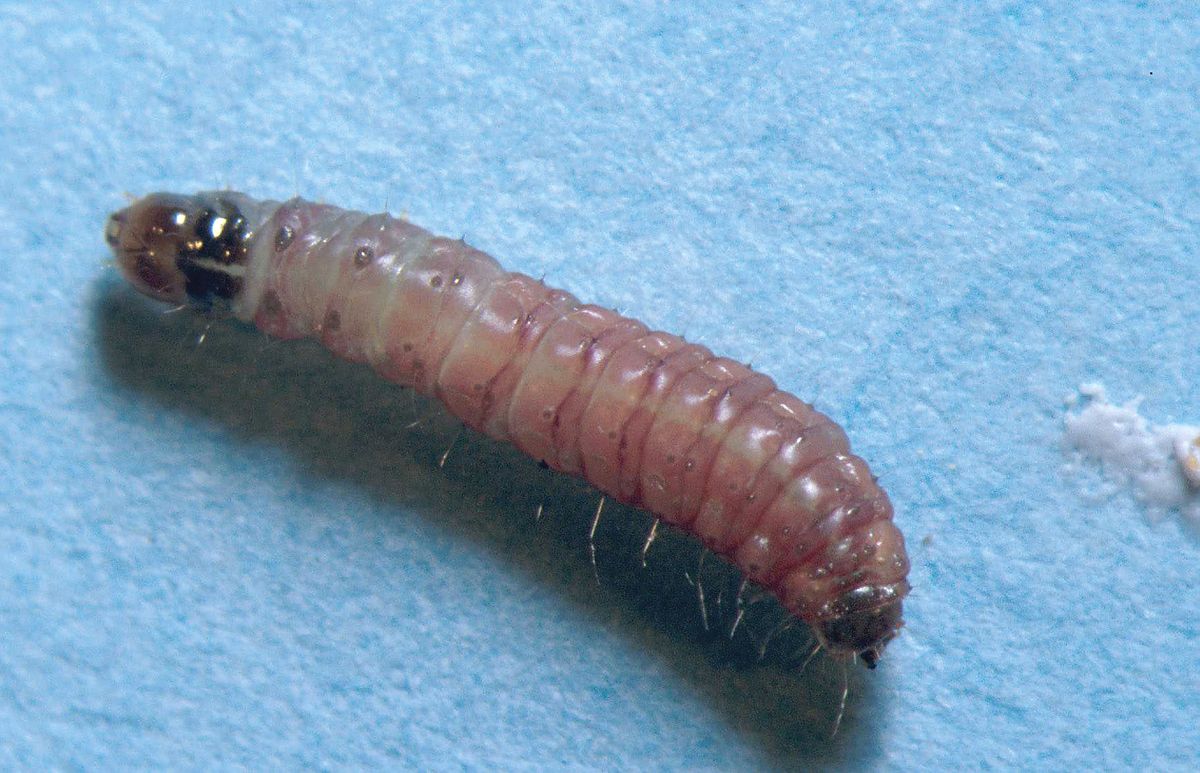 Source:Steve Kerr (CC BY). |
| Guava moth adult |  Source: Andrew Jensen (CC BY-NC-SA). Source: Andrew Jensen (CC BY-NC-SA). |
Damage
Infestation is usually at the bottom end of the fruit. Early fruit drop can be the first indicator of the problem.
Tracy Bain in Understanding the Guava Moth Pest, 2016
Understanding the Guava Moth Pest, 2016The caterpillar leaves rotting, brown patches, excreta and mould inside the fruit, making it inedible and it causes early fruit drop.
If you’re interested in reading a biological description of the guava moth, this book from 1882 provides a fascinating look into insect descriptions: The Proceedings of the Linnean Society of New South Wales, Volume VI.
Psyllids (family: Psyllidae)
In Module 2 we looked specifically at the tomato/potato psyllid (Bactericera cockerelli) but there are many more species of psyllids found in Aotearoa, including the kowhai psyllid (Psylla apicalis) and the pittosporum psyllid (Trioza vitreoradiata).
Lifecycle stages
Psyllids have a three-stage lifecycle:
- Egg: Female psyllids lay their eggs on the leaves of plants.
- Nymph: When the eggs hatch, the psyllids emerge as nymphs. The nymphs resemble the adult psyllids but are smaller and lack wings. They feed on the sap of the plant and moult several times as they grow.
- Adult: Once the nymphs have completed their final moult, they emerge as adult psyllids. The adults have wings and are capable of flying. They continue to feed on the sap of the plant and mate to produce offspring.
In some psyllid species, the adults enter a state of diapause, or suspended animation, during the winter months. They may seek shelter under tree bark or in other protected areas.
Identifying features
Psyllids are a diverse group of insects, and their appearance can vary depending on the species. However, there are several common identifying features of psyllids that can help distinguish them from other insects. For adults, these include:
- Size: Psyllids are generally small insects, typically ranging in size from 1-7mm in length.
- Shape: Psyllids have a distinctive shape that is somewhat flattened and resembles a small cicada. They have a triangular head, a broad pronotum (the segment behind the head), and a tapered abdomen.
- Wings: Most psyllids have two pairs of wings, although some species may be wingless. The front wings are usually larger and thicker than the hindwings and are held roof-like over the body at rest.
- Colour: Psyllids may be green, brown, black, or a combination of these colours. Some species have distinct patterns or markings on their wings or body.
- Antennae: Psyllids have short, segmented antennae that are usually less than half the length of their body.
- Feeding behaviour: Psyllids are sap-sucking insects that feed on the leaves, stems, and/or roots of plants.
Nymphs are smaller than adults and lack wings. They are usually more rounded in shape, with a less developed pronotum and abdomen. They may also have a slightly different coloration compared to adults.
The eggs are small and oval-shaped and are usually laid in clusters.
| Adult kowhai psyllid (Psylla apicalis). | ![[ADD IMAGE'S ALT TEXT]](/sites/default/files/Kowhai_Psyllid_Psylla_apicalis_Steve_Kerr_CCBY_0.jpg) Source: Steve Kerr (CC BY) |
| Tomato/potato psyllid (Bactericera cockerelli) adult and nymphs. | ![[ADD IMAGE'S ALT TEXT]](/sites/default/files/Bactericera.jpg) Source: Andrew Jensen (CC BY-NC-SA). |
Damage
Psyllids cause damage during both the nymph and adult stages. They insert their needle-like mouthparts into the plant's tissue and suck out the sap. This feeding can cause a range of symptoms, including yellowing or browning of the leaves, stunted growth, and reduced yield in crops. Psyllids can also transmit plant pathogens, such as bacteria and viruses, which can cause further damage to the plants they infest.
In general, psyllids are more active during the warmer months, with peak activity typically occurring in late spring and early summer (November to December). During this time, psyllids are more likely to be feeding and reproducing, which can lead to increased damage to plants.
However, some psyllid species may also be active during other times of the year, depending on their life cycle and the climate conditions in the region. For example, the tomato/potato psyllid (Bactericera cockerelli), which is a significant pest in Aotearoa, can be active year-round in warmer areas of the country, while in cooler areas, its activity may be restricted to the summer months.
Root mealybug (Rhizoecus spp.)
![[ADD IMAGE'S ALT TEXT]](/sites/default/files/Root%20mealybug.jpg)
The term mealybug is often used to refer to various species of scale insects. Mealybugs are characterised by their small, oval-shaped bodies covered in a white, powdery wax that resembles meal, or cotton. They feed on the sap of plants and can cause significant damage to crops, ornamental plants, and indoor plants.
Root mealybug, or ground mealybug (Rhizoecus spp.) specifically infects the roots of plants.
Lifecycle stages
Root mealybugs have a three-stage lifecycle:
- Egg: The eggs are small and oval-shaped and are usually laid in the soil or in plant crevices.
- Nymph: After hatching, the nymphs emerge and begin to feed on plant roots. The nymphs are similar in appearance to the adults but are smaller and lack wings and reproductive organs. As the nymphs grow and moult several times, they eventually reach adulthood.
- Adult: Adult mealybugs are around 2-4mm long and have a distinctive white, powdery wax covering their bodies. They have well-developed legs and antennae, as well as wings in some species.
Identifying features
Adult root mealybugs can be identified by their:
- Size: Around 2-4mm long.
- Shape: Oval-shaped body, with well-developed legs and antennae. Females have a segmented ovipositor used to lay eggs.
- Waxy coating: Covered in a white, powdery wax that resembles cotton or meal.
- Environment: Found in the soil and on plant roots.
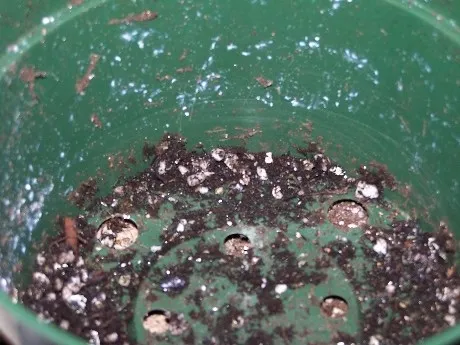
This pot shows powdery blue residue after the plant has been removed, which indicates the soil is hosting root mealybugs.
Damage
Because root mealybugs spend most of their time in the soil, they can be hard to identify. More often, it is a case of seeing plant damage and then pulling up the plants or digging in the soil to confirm that the damage is from root mealybugs.
Signs to look for include:
- stunted growth: Plants infested with root mealybugs may show signs of stunted growth, as the insects can disrupt the normal flow of nutrients and water from the roots to the rest of the plant.
- wilting and yellowing leaves: As the roots become damaged, the plant may begin to wilt or show signs of yellowing or browning leaves.
- reduced vigour: Infested plants may appear weaker or less healthy than unaffected plants, with smaller leaves or fewer flowers.
- plant death: In severe cases, root mealybug infestations can cause the plant to die, particularly if the root system is heavily damaged.
- sticky or honeydew-covered plant surfaces: root mealybugs excrete a sugary substance known as honeydew, which can accumulate on the leaves and stems of infested plants. This can attract other pests like ants and can promote the growth of fungal diseases.
Have you seen this?
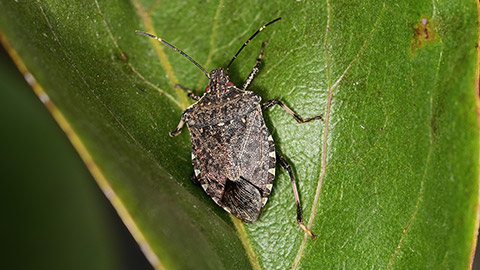
This marmorated stink bug (Halyomorpha halys) is an extremely damaging pest in New Zealand. There are several insects in the same family that look similar but are not as destructive such as the southern green stink bug we introduced in the previous section.
Biosecurity New Zealand launched a campaign in 2020 to raise awareness. Learn to recognise this pest at M.P.I. (Ministry for Primary Industries).
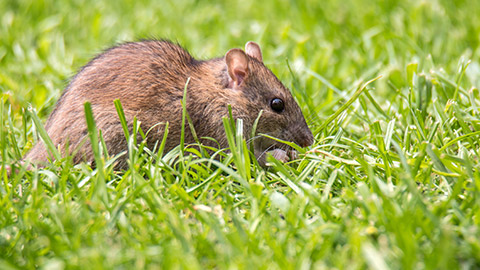
Brown rats (Rattus norvegicus) affect horticulture in New Zealand by eating the eggs of pollinating bird species, young birds, and seeds. This introduced species affects the balance of biodiversity, which can impede healthy plant growth and reproduction.
In this topic, we focused on insects and insect pests, but remember, you may also need to protect your garden from other pest species.
Take a look at the Department of Conservation website, which provides some information about other common pests found in Aotearoa:
- Are any of these pests found in your area?
- Were you surprised to learn about any of these species?
Auckland Botanic Gardens talks about the wider benefits of controlling larger pests and the benefits of pest control more broadly. It also gives advice about effective pest trapping.
Before continuing with the lesson, let's review some of the things you've learned about insects.
Activity – Learning checkpoint
Task 1:
Task 2:
Task 3:
Task 4:
Each of these four questions has one answer and the quiz progresses automatically.
